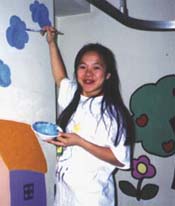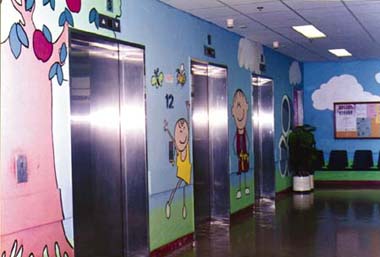|
Art: Plan to enliven hospitals dies from lack of funds By Cherry Lam |
|
The scheme started its first work at Prince of Wales Hospital in 1994. It was the first large-scale and long-term art scheme integrating art into hospitals. The scheme’s objective was to transform hospitals into more harmonious and cheerful places. Said Ms Lam Wai-kit, the project coordinator of the Art in Hospital Scheme: “Our effort was highly appreciated by the general public, patients and hospital staff. Many artists still want to join but they will have no more chances now.” |
Courtesy of Playright Artists enjoy decorating hospitals, but have fewer chances now. |
|
After 3 years’ operation and the involvement of more than 30 artists and 300 volunteers, the scheme’s funding had dried up by the end of September. Cartoonist Zunzi’s mural at St. John Hospital on Cheung Chau Island was the scheme’s last artwork. “With the paintings in the paediatric wards, children feel happier as if they are at schools,” said Mr. Anthony Tang, the patient relation officer of St. John Hospital. While some hospitals approached the Art in Hospital Scheme, others approached individual artists. Mr. Shi Jun of The Prima Club was invited by Princess Margaret Hospital to paint cartoons on their paediatric wards’ walls. Patients in the paediatric wards find it more comfortable to live in hospitals with the colourful paintings. There were clear advantages in launching these projects in hospitals. “Hospital staff are very cooperative,” said project coordinator Ms Lam. “Their presence around the clock was a great advantage because we could choose the time we prefer.” “It is easy to find volunteer artists and helpers. Many of them said they would join again after seeing their artwork had satisfactory results,” added she. Said Ms Lee Pui-yu, an artist who worked on murals at Pamela Youde Nethersole Eastern Hospital: “I participated in the scheme because I liked this meaningful way of serving children.” “I am sad about the ending of this project,” said Ms Lee. “The demand for colours is large in all hospital wards.” Ms Cindy Yan, the assistant manager of workshop instructor of a sheltered workshop in Sham Shui Po, was a volunteer helper of the scheme. She said, “I learned about this scheme from booklets and took part in it because I liked the idea. “I had a cold and a separate hospital experience years ago. But now I know that life in hospitals can be much more colourful.” |
Courtesy of Playright |
|
The ending of the Art in Hospital Scheme has aroused concern over this kind of project. The Pamela Youde Nethersole Eastern Hospital is organising a project to draw murals for their own hospital. Financial problems are the major limitation for launching art projects in hospitals, and they are difficult to overcome. The main expenditure of the Art in Hospital Scheme is the administrative cost, which includes salaries for staff and costs of painting and publicity. Said Mr. Oscar Ho, the exhibition director of the Hong Kong Art Centre: “Our centre and the Garden Streams Hong Kong Fellowship of Christian Artists tried hard to find sponsors. But it was difficult because the scheme was not attractive for businessmen as a hospital project.” “We relied on donations,” said Mr. Ho. “As the scheme began to target a larger number of hospitals, we needed a more stable income.” The Hong Kong Art Development Council subsidized the Art in Hospital Scheme to the tune of $200,000 a year in the past 3 years. But the term ended in September. The Art Development Council suggested to scheme coordinators that they request 50 percent of their total expenditure from the Hospital Authority, and then it would sponsor the other half as a matching grant. However, the Hospital Authority refused the request because it did not have a budget for the scheme. “That is why the scheme fell apart,” said Mr. Ho. The Art Development Council said it would reconsider sponsorship if scheme coordinators reapply. |
 Live out the excitement
Live out the excitement
December 1997
[Editorial] [Letters] [Answer] [News] [Social] [Photo] [Culture] [Education] [Channels] [Science] [Celebrity]
Comments Editor-in-Chief Electronic Editor